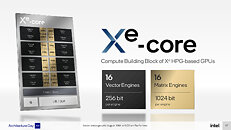
UL Launches New 3DMark Feature Test for Intel XeSS
We're excited to release a new 3DMark feature test for Intel's new XeSS AI-enhanced upscaling technology. This new feature test is available in 3DMark Advanced and Professional Editions. 3DMark feature tests are special tests designed to highlight specific techniques, functions, or capabilities. The Intel XeSS feature test shows you how XeSS affects performance.
The 3DMark Intel XeSS frame inspector tool helps you compare image quality with an interactive side-by-side comparison of XeSS and native-resolution rendering. Check out the images below to see an example comparison of native resolution rendering and XeSS in the new 3DMark feature test.
The 3DMark Intel XeSS frame inspector tool helps you compare image quality with an interactive side-by-side comparison of XeSS and native-resolution rendering. Check out the images below to see an example comparison of native resolution rendering and XeSS in the new 3DMark feature test.









































































